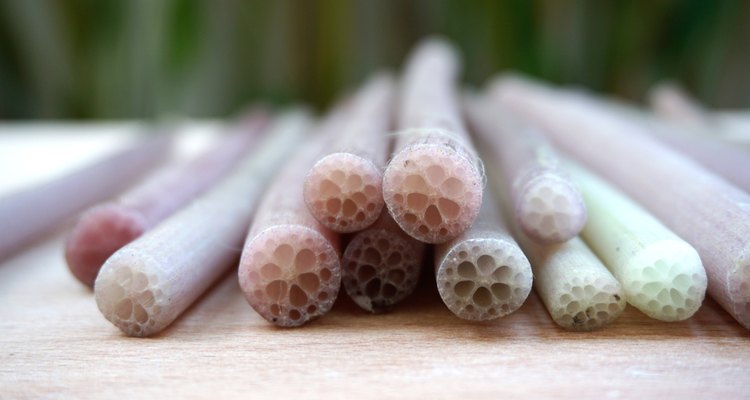
Augustcindy/iStock/Getty Images
Lotus stem, or kamal kakdi, is a common vegetable in Indian cuisine, although it might not be easily found in your grocery store's produce section. It may be worth the effort of seeking it out in specialty markets, however, as lotus stem offers a range of health and medical benefits. Do not eat lotus stem to treat a medical problem without consulting your physician.
About Lotus Stem
Lotus stem is generally round, and white to light green. It contains hollow air cubicles that run the length of the stem. The vegetable has a mild, slightly sweet flavor and is suitable for eating raw or cooked. You might see this vegetable raw in salads, pickled or cooked into curries and stir-fried with pork or seafood. According to Auburn University, lotus seeds can be ground and used as flour, the roots cooked like sweet potatoes and the leaves used as spinach.
Nutritional Benefits
Eat lotus stem, and you take in a rich source of calcium, iron and fiber. The calcium in lotus stem influences bone strength and density as well as heart function. The iron you get from this vegetable is useful for boosting hemoglobin and myoglobin production in your blood. The fiber in lotus stem is critical for helping you to maintain digestive and bowel health.
Medical Benefits
Eat lotus stems to increase your intake of antioxidants. A study published in the June 2010 issue of the "International Journal of Food Sciences and Nutrition" investigated various vegetables, including edible lotus, for their antioxidant activities. Edible lotus proved to contain tryptophan, an amino acid that influences antioxidant activity. Antioxidants protect the cells of your body from free radicals, compounds found in environmental toxins that can damage cells.
Considerations
Because lotus stems are not readily available in the United States, you may opt to grow them at home in a water garden. While nutritious and ornamental, lotus can spread rapidly and become invasive, and can damage native flora. Take steps to control lotus growth. Lotus can be grown in containers and then placed in ponds. This is one way to control their environmental impact and still enjoy their beauty.
Related Articles
How Do I Clean Water Cress?

Wild Yam for Hair Growth

How to Cook Yucca Root

Peeling the Spiny Chayote Squash

List of Wild Edible Plants & Berries in ...

What Are the Benefits of Kyo-Green?

How to Parboil Artichokes

The Effects of Organic Fertilizer on ...

About Seaweed and Hair Growth

Burdock Root for Acne

Mushrooms Found in Northern Michigan

Nutrition Information on Blueberries

What Is White Squash?

Vitamins for Mental Alertness

How to Use Wheatgrass for Washing Hair

How to Use Lettuce for Hair Growth

How to Freeze Ramps & Wild Leeks

How to Eat a Kiwano Horned Melon

What Kinds of Nuts Don't Grow on Trees?

What Are the Benefits of Persimmons?
References
- Tarladalal.com: Lotus Stem
- University of Maryland Medical Center: Calcium
- Office of Dietary Supplements: Iron
- FamilyDoctor.org: Fiber: How To Increase The Amount In Your Diet
- International Journal of Food Sciences and Nutrition; First Isolation of Tryptophan From Edible Lotus (Nelumbo nucifera Gaertn) Rhizomes and Demonstration of its Antioxidant Effects; Y. Jiang, et al.
- MedlinePlus: Antioxidants
- International Waterlilly and Water Gardening Society
- Auburn University: The Auburn University Lotus Project
Writer Bio
Nicki Wolf has been writing health and human interest articles since 1986. Her work has been published at various cooking and nutrition websites. Wolf has an extensive background in medical/nutrition writing and online content development in the nonprofit arena. She graduated with a Bachelor of Arts in English from Temple University.
Photo Credits
Augustcindy/iStock/Getty Images